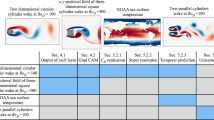Abstract
Estimating unknown parameters or conditions based on observation in a numerical model is a problem considered in data assimilation. In this study, we investigate a data assimilation approach using an image-processing deep neural network (DNN) as a likelihood function. The DNN is trained by observed images and tests visualized images generated by numerical simulation. This approach does not provide exact comparison of observed and simulated images for constructing the likelihood function. However, it would be effective when exact comparison is difficult due to noise or complex measurement procedures. The effectiveness of this approach is investigated by a vortex flow around a circular cylinder moving freely in the crossflow direction, realizing vortex-induced vibration (VIV). The DNN trained by wake visualization images from the VIV experiment tests pseudo-wake images from the numerical simulation to estimate VIV amplitude and frequency parameters. By evaluating the confidence score of the DNN from the simulated images with different amplitude and frequency values, these input parameters can be estimated based on the experimental VIV images, resulting in data assimilation with a likelihood function based on the DNN. The results showed that the amplitude and frequency of the VIV can be approximated from the experimental images.














Similar content being viewed by others
References
Bishop CM (2011) Pattern recognition and machine learning. Springer
Forrester AIJ, Sóbester A, Keane AJ (2007) Multi-fidelity optimization via surrogate modelling. P Roy Soc A-Math Phy 463:3251–3269
Hirt CW, Cook JL (1972) Calculating three-dimensional flows around structures and over rough terrain. J Comput Phys 10:324–340
Jiao L, Zhang F, Liu F, Yang S, Li L, Feng Z, Qu R (2019) A survey of deep learning-based object detection. arXiv:1907.09408
Jones DR, Schonlau M, Welch WJ (1998) Efficient global optimization of expensive black box functions. J Glob Optim 13:455–492
Kalnay E (2003) Atmospheric modeling, Data Assimilation and Predictability. Cambridge University Press
Kawamura T, Kuwahara K (1984) Computation of high Reynolds number flow around a circular cylinder with surface roughness. AIAA Paper 84-0340
Kikuchi R, Misaka T, Obayashi S (2016) Real-time prediction of unsteady flow based on POD reduced-order model and particle filter. Int J Comput Fluid D 30:285–306
Microsoft (2019) VoTT (Visual Object Tagging Tool), https://github.com/microsoft/VoTT. Accessed 20 Nov 2019
Misaka T (2019) Bounding box coordinates of von Karman vortex street. Zenodo. https://doi.org/10.5281/zenodo.3609344
Misaka T, Obayashi S (2014) Sensitivity analysis of unsteady flow fields and impact of measurement strategy. Math Probl Eng 2014:359606-1-12
Misaka T, Obayashi S, Endo E (2008) Measurement-integrated simulation of clear air turbulence using a four-dimensional variational method. J Aircr 45:1217–1229
Mittal R, Iaccarino G (2005) Immersed boundary methods. Annu Rev Fluid Mech 37:239–261
Munir A, Zhao M, Wu H, Lu L, Ning D (2018) Three-dimensional numerical investigation of vortex-induced vibration of a rotating circular cylinder in uniform flow. Phys Fluids 30:0536021
Redmon J, Farhadi A (2017) Yolo9000: better, faster, stronger. IEEE Conference on Computer Vision and Patter Recognition (CVPR), pp. 6517-6525
Redmon J, Farhadi A (2018) YOLOv3: an incremental improvement, arXiv:1804.02767. https://pjreddie.com/darknet/yolo/. Accessed 20 Nov 2019
Redmon J, Divvala S, Girshick R, Farhadi A (2015) You look only once: unified real-time object detection. arXiv:1506.02640
Seyed-Aghazadeh B, Modarres-Sadeghi Y (2015) An experimental investigation of vortex-induced vibration of a rotating circular cylinder in the crossflow direction. Phys Fluids 27:067101-1-16. https://doi.org/10.1063/1.4921683
Tan RK, Zhang NL, Ye W (2019) A deep learning–based method for the design of microstructural materials. Struct Multidiscip Optim. https://doi.org/10.1007/s00158-019-02424-2
Togashi F, Misaka T, Löhner R, Obayashi S (2018) Using ensemble Kalman filter to determine parameters for computational crowd dynamics simulations. Eng Comput 35:2612–2628
Yonekura K, Hattori H (2019) Framework for design optimization using deep reinforcement learning. Struct Multidiscip Optim 60:1709
Zhang Y, Ye W (2019) Deep learning–based inverse method for layout design. Struct Multidiscip Optim 60:527
Funding
This work was partially supported by JSPS KAKENHI Grant Number 17K17592.
Author information
Authors and Affiliations
Corresponding author
Ethics declarations
Conflict of interest
The author declares no conflict of interest.
Replication of results
The videos of the VIV experiment are available from the journal website (Seyed-Aghazadeh and Modarres-Sadeghi 2015). The annotation of experimental images was conducted using an annotation tool VoTT (Microsoft 2019) and the resulting bounding box coordinates are available on the data repository (Misaka 2019). YOLOv3 for deep learning used here is the same as on Redmon’s website (Redmon and Farhadi 2018), where the output part of the confidence score was slightly modified to calculate the average. The Kriging code is implemented by Fortran based on Jones et al. (1998). The MCMC routine is based on a standard algorithm (Bishop 2011). The Fortran code for the VIV simulation can be made available by request to interested researchers via the corresponding author.
Additional information
Responsible Editor: Palaniappan Ramu
Publisher’s note
Springer Nature remains neutral with regard to jurisdictional claims in published maps and institutional affiliations.
Rights and permissions
About this article
Cite this article
Misaka, T. Image-based fluid data assimilation with deep neural network. Struct Multidisc Optim 62, 805–814 (2020). https://doi.org/10.1007/s00158-020-02537-z
Received:
Revised:
Accepted:
Published:
Issue Date:
DOI: https://doi.org/10.1007/s00158-020-02537-z




